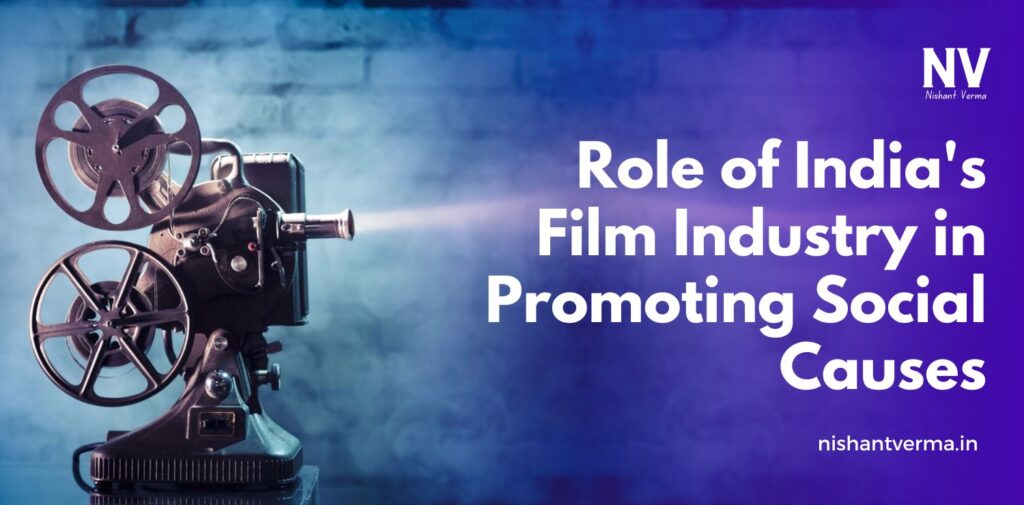Indian film industry, widely known as Bollywood, has always been an essential part of the country’s culture and entertainment landscape. Beyond just entertainment, Indian cinema has played a significant role in raising awareness about social issues and promoting positive change in society. Through powerful storytelling, impactful performances, and thought-provoking themes, Indian filmmakers have been able to highlight crucial social causes. Over the years, the industry has evolved from simply being a source of entertainment to becoming a platform for social transformation. This article explores the various ways in which India’s film industry has contributed to promoting social causes and influencing public perception.
Cinema as a Mirror to Society
The film industry has always had a unique ability to reflect the changing dynamics of society. Indian cinema, with its wide reach and mass appeal, has often been at the forefront of bringing societal issues to the mainstream. Films have addressed problems such as caste discrimination, gender inequality, poverty, child labor, communalism, and the fight for justice, among many others.
For example, the classic film Mother India (1957) portrayed the struggles of a rural woman fighting against poverty and oppression. It became a symbol of India’s resilience in the face of adversity. Similarly, films like Satyam Shivam Sundaram (1978) touched upon themes of beauty, both internal and external, challenging societal notions of physical appearance.
Through stories that resonated with the common man, these films did not just entertain but also acted as a mirror to the issues that the society was grappling with. They inspired a collective awareness, encouraging conversations about the challenges people faced, and motivated many to act towards social change.

Tackling Social Issues through Storytelling
Indian filmmakers have used their creativity to address a wide range of social causes in their films. For instance, films like Toilet: Ek Prem Katha (2017) brought attention to sanitation issues in rural India, emphasizing the importance of proper sanitation facilities and hygiene. The film not only entertained audiences but also triggered nationwide discussions on the need to build toilets in rural areas to improve health and dignity.
Another example is Dangal (2016), which focused on women’s empowerment in the context of sports. The film depicted the inspiring true story of Geeta Phogat, an Indian wrestler who overcame societal norms and family opposition to achieve greatness in the male-dominated sport. Dangal became a cultural phenomenon, spreading the message of female empowerment, the importance of sports for women, and the significance of family support in achieving dreams.
Movies like Padman (2018) and Chhapaak (2020) tackled topics related to menstrual hygiene and acid attack survivors, respectively, while also addressing the stigma surrounding these issues. By creating awareness about such taboo subjects, these films encouraged open dialogue and social acceptance. The success of these movies showed that Indian audiences were ready to embrace films that dealt with important social issues and recognized their role in shaping public opinion.
Cinema and Gender Equality
One of the most profound impacts of Indian cinema on social causes has been its contribution to the ongoing conversation around gender equality. For decades, women in Indian cinema were often relegated to secondary roles, with their identities defined largely by male characters. However, in recent years, Bollywood has evolved to give more prominent roles to women, with films that highlight gender issues and promote women’s rights.
Films such as Queen (2013), Piku (2015), and Tumhari Sulu (2017) focus on the emotional and personal journeys of women who break free from societal expectations and chart their own path. These films portray women as strong, independent, and capable of making their own decisions, helping to change the narrative around female empowerment.
Moreover, Kabir Singh (2019) and Tanu Weds Manu (2011) sparked debates on toxic masculinity and the need to redefine masculinity in Indian society. While these films received mixed responses, they undoubtedly started conversations about gender roles, relationship dynamics, and the need for more progressive attitudes toward both men and women.
The role of women as protagonists, the portrayal of strong female characters, and the discussion of important social issues related to gender have made Indian cinema a powerful tool in advocating for gender equality and women’s empowerment.

Raising Awareness About Environmental Issues
In addition to social issues such as gender equality, Indian film industry has also used its platform to raise awareness about environmental concerns. With the rapid pace of urbanization, pollution, and climate change, the environment has become one of the most pressing issues of our time.
Films like Peepli Live (2010) and Swades (2004) touched upon themes of environmental sustainability and rural development. Peepli Live humorously tackled the issue of farmer suicides and the lack of government support for the agricultural community, indirectly addressing the environmental challenges faced by farmers. Swades, starring Shah Rukh Khan, highlighted the issues of rural development, the impact of migration, and the need for environmental conservation, focusing on the importance of sustainable living and community development.
In recent years, films like Jal (2013) and Lagaan (2001) have highlighted the importance of water conservation, rural livelihoods, and the devastating effects of droughts. These films have not only entertained but also educated audiences about the pressing environmental issues faced by rural India.
Through powerful narratives and emotional storytelling, Indian cinema has succeeded in raising awareness about the environmental crises that threaten the nation’s future. The message of environmental sustainability and responsibility has found its way into mainstream cinema, encouraging viewers to reflect on their own practices and contribute to the preservation of the planet.
Bollywood and Social Movements
Bollywood’s influence extends beyond films, as actors and filmmakers often take active roles in social movements and activism. Many Bollywood stars use their celebrity status to amplify causes they believe in, further enhancing the impact of Indian cinema on social issues.
For instance, actor Aamir Khan has been at the forefront of several social causes through his television show Satyamev Jayate, which addressed issues like female foeticide, child sexual abuse, and medical malpractices. Similarly, actress Deepika Padukone used her platform to bring attention to mental health awareness through her film Chhapaak, where she portrayed an acid attack survivor, and through her personal advocacy work.
Celebrities also participate in charity events, fundraising campaigns, and awareness programs, contributing to social causes both on-screen and off-screen. Their ability to connect with millions of people through their influence and popularity has given them a unique opportunity to promote social change. Bollywood’s involvement in social movements like Beti Bachao Beti Padhao and Swachh Bharat Abhiyan has reinforced the role of entertainment in promoting important causes.

The Role of Film Festivals in Promoting Social Causes
Indian film festivals such as the Mumbai Film Festival (MAMI) and International Film Festival of India (IFFI) provide a platform for filmmakers to showcase their works that highlight important social causes. These festivals not only serve as a celebration of cinematic excellence but also act as a space for discussion on critical societal issues. Many independent filmmakers have used these platforms to share stories that highlight challenges like caste discrimination, rural poverty, human trafficking, and more.
Films that are screened at these festivals often receive recognition for their socially relevant themes, which helps in furthering public discourse around these issues. The awards and attention received by these films bring global attention to Indian social issues, encouraging international dialogue and understanding.
Conclusion: Role of Indian Film Industry
Indian cinema has come a long way from being a simple form of entertainment to becoming an influential medium for social change. Through powerful storytelling, the film industry has been able to shine a light on critical issues that affect the nation and the world. From gender equality and environmental sustainability to poverty, education, and health, Bollywood has taken on the responsibility of shaping public opinion and encouraging social transformation.
The impact of Indian films in promoting social causes cannot be underestimated. They have inspired millions, created awareness, and sparked important conversations. As India continues to evolve, the film industry will remain a vital tool in advancing social causes and promoting a more just and equitable society. Through cinema, India’s storytellers have shown that entertainment and activism can go hand in hand, creating a positive impact that transcends the silver screen.




